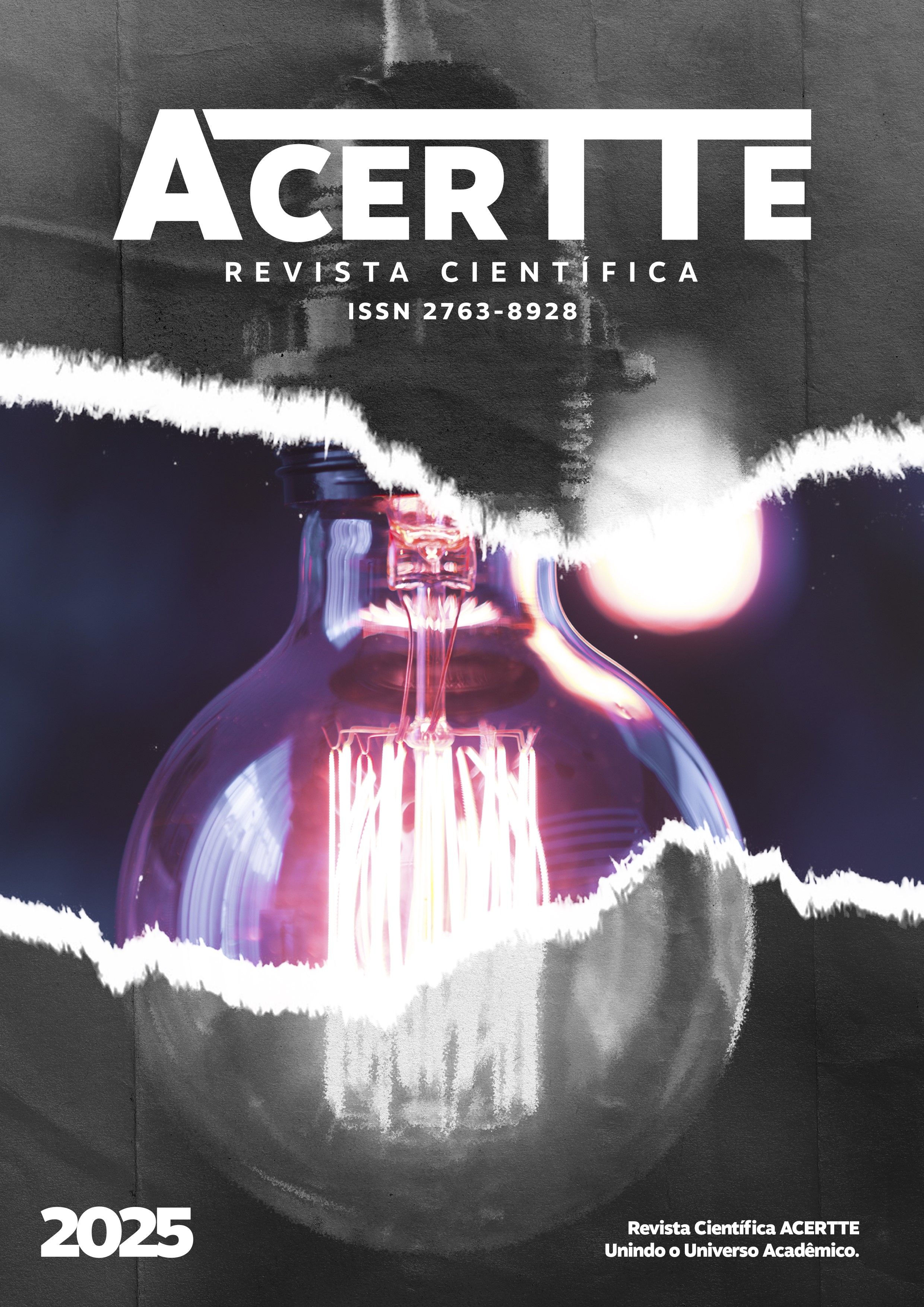THE BENEFITS OF CONTINUOUS MONITORING BY VIDEOELECTROENCEPHALOGRAPHY IN HOSPITAL MANAGEMENT
DOI:
https://doi.org/10.63026/acertte.v5i3.226Keywords:
Videoelectroencephalography. Continuous monitoring. Hospital management.Abstract
Introduction: Videoelectroencephalography (VEEG) monitoring can be resource-intensive, especially in large medical centers, but few studies have addressed its cost-effectiveness. Justification: Because it is a very specific focus on procedures for hospitalized patients, the benefits of VEEG need to be evaluated to draw the attention of researchers to further studies on this topic. Methodology: From a methodological point of view, this study consists of the elaboration of bibliographic research on the most recent publications that address the theoretical and practical concepts related to the use of VEEG in the continuous monitoring of patients admitted to hospitals, with neurological disease for which the application of this procedure has indicated. Discussion: the video-electroencephalographic record with surface electrodes must always take into account the cost-benefit relation in hospital management. and be interpreted in the context of the other tests that make up the battery for the evaluation of hospitalized patients. Conclusion: Although VEEG monitoring has a high cost due to the team and equipment, the cost savings for public and private health are enormous, mainly because of the correct diagnosis and improvement in the control of crises caused by neurological diseases.
Downloads
References
BENICZKY, S.; LANTZ, G.; ROSENZWEIG, I.; AKESON, P.; PEDERSEN, B.; PINBORG, LH; et al. Source localization of rhythmic ictal EEG activity: A study of diagnostic accuracy following STARD criteria. Epilepsia, v. 54, p. 1743-1752, 2013. DOI: https://doi.org/10.1111/epi.12339
BERGEN, D. C. The worldwide burden of neurologic disease. Neurology, v. 47, p. 21-25, 1996. DOI: https://doi.org/10.1212/WNL.47.1.21
BERMEO-OVALLE, A. Bringing EEG back to the future: Use of cEEG in neurocritical care. Epilepsy Currents, v. 19, n. 4, p. 243–245, 2019. DOI: https://doi.org/10.1177/1535759719858350
BIASIUCCI, A.; FRANCESCHIELLO, B.; MURRAY, M. M. Electroencephalography. Current Biology, v. 29, p. R71–R85, 4 fev. 2019. DOI: https://doi.org/10.1016/j.cub.2018.11.052
BROPHY, G. M. et al. Guidelines for the evaluation and management of status epilepticus. Neurocritical Care, v. 17, n. 1, p. 3–23, 2012. DOI: https://doi.org/10.1007/s12028-012-9695-z
BUSL, K. M.; BLECK, T. P.; VARELAS, P. N. Neurocritical care outcomes, research, and technology: A review. JAMA Neurol, 2019. DOI: https://doi.org/10.1001/jamaneurol.2018.4407
CASCINO, G. D. Clinical indications and diagnostic yield of videoelectroencephalographic monitoring in patients with seizures and spells. Mayo Clinic Proceedings, v. 77, p. 1111-1120, 2002. DOI: https://doi.org/10.4065/77.10.1111
CASCINO, G. D. Video-EEG monitoring in adults. Epilepsia, v. 43, p. 80-93, 2002. DOI: https://doi.org/10.1046/j.1528-1157.43.s.3.14.x
CHEMMANAM, T.; RADHAKRISHNAN, A.; SARMA, S. P.; RADHAKRISHNAN. A prospective study on the cost-effective utilization of long-term inpatient video-EEG monitoring in a developing country. Journal of Clinical Neurophysiology, v. 26, p. 123-128, 2009. DOI: https://doi.org/10.1097/WNP.0b013e31819d8030
CLAASSEN, J. et al. Recommendations on the use of EEG monitoring in critically ill patients: Consensus statement from the neurointensive care section of the ESICM. Intensive Care Medicine, v. 39, n. 8, p. 1337–1351, 2013. DOI: https://doi.org/10.1007/s00134-013-2938-4
CLANCY, R. R.; BERGVIST, A. G. C.; DLUGOS, D. J.; NORDLI, D. R. Normal pediatric EEG: Neonate and children. In: EBERSOLE, J. S. (Ed.). Current Practice of Clinical Electroencephalography. 4. ed. Philadelphia: Lippincott Williams & Wilkins, 2014. p. 125-212.
FLEURY, Artigos Científicos. Monitorização por vídeo-EEG no diagnóstico de fenômenos paroxísticos. São Paulo, maio 2010.
FOSSAS, P.; FLORIACH-ROBERT, M.; CANO, A.; PALOMERAS, E.; SANZ-CATAGENA, P. Utilidad clínica del videoelectroencefalograma en regimen ambulatorio. Revista Neurología, v. 40, p. 257-265, 2005. DOI: https://doi.org/10.33588/rn.4005.2004543
FRIEDMAN, D.; CLAASSEN, J.; HIRSCH, L. J. Continuous electroencephalogram monitoring in the intensive care unit. Anesthesia and Analgesia, 2009. DOI: https://doi.org/10.1213/ane.0b013e3181a9d8b5
GHOUGASSIAN, D.; D'SOUZA, W.; COOK, M. J.; O'BRIEN, T. J. Evaluating the utility of inpatient video-EEG monitoring. Epilepsia, v. 45, p. 928-932, 2004. DOI: https://doi.org/10.1111/j.0013-9580.2004.51003.x
GOMES, M. D. M. História da epilepsia: Um ponto de vista epistemológico. Journal of Epilepsy and Clinical Neurophysiology, v. 12, n. 3, p. 161–167, 2007. DOI: https://doi.org/10.1590/S1676-26492006000500009
HILL, C. E. et al. Bringing EEG back to the future: Use of cEEG in neurocritical care. Neurology, Epilepsy Currents, 2019.
HOLCK, S. et al. The WHO report 2001: Mental health: New understanding, new hope. 2001.
LOWENSTEIN, D. H. et al. A definition and classification of status epilepticus - Report of the ILAE Task Force on Classification of Status Epilepticus. Epilepsia, v. 56, n. 10, p. 1515–1523, 2015. DOI: https://doi.org/10.1111/epi.13121
MARQUES, Lúcia Helena Neves; ALMEIDA, Sérgio J. A.; SANTOS, Adriana B. Monitorização vídeo-EEG prolongada em crises não epilépticas, semiologia clínica. Arq. Neuropsiquiatria, v. 62, n. 2-B, p. 463-468, 2004. DOI: https://doi.org/10.1590/S0004-282X2004000300016
MEHTA, A. B.; BURROUGHS, A. K.; NYDEGGER, U. E. ILAE classification of the epilepsies: Position paper of the ILAE Commission for Classification and Terminology. Epilepsia, v. 58, n. 4, p. 960–961, 2017. DOI: https://doi.org/10.1111/epi.13709
MONNERAT, B. Z. Convergência da videoeletroencefalografia prolongada e da ressonância magnética de encéfalo na determinação de zonas epileptogênicas extrahipocampais presumidas. Ribeirão Preto: Universidade de São Paulo, 136 p., 2016.
MORALES, Chacón, L. M.; BOSCH, B. J.; BENDER DEL BUSTO, J. E.; GARCIA, M. I. Evaluación videoelectroencefalográfica complementada con análisis espectral y de las fuentes generadoras del electroencefalograma en pacientes con epilepsia del lóbulo temporal medial resistente a los fármacos. Havana: Centro Internacional de Restauración Neurológica, 2007. DOI: https://doi.org/10.33588/rn.4403.2006090
NEY, J. P.; VAN DER GOES, D. N.; NUWER, M. R.; NELSON, L.; ECCHER, M. A. Continuous and routine EEG in intensive care: Utilization and outcomes, United States 2005-2009. Neurology, 2013. DOI: https://doi.org/10.1212/01.wnl.0000436948.93399.2a
SCHEFFER, I. E. et al. Classificação da ILAE das epilepsias: Artigo da posição da Comissão de Classificação e Terminologia da International League Against Epilepsy. 1-25, 2017.
SOUSA, P. S. Estudo vídeo-eletroencefalográfico do efeito de fatores precipitantes em pacientes com epilepsia mioclônica juvenil. Tese de doutorado, Universidade Federal de São Paulo, São Paulo, 2006. 170 p.
SUAREZ, J. I.; ZAIDAT, O. O.; SURI, M. F.; et al. Length of stay and mortality in neurocritically ill patients: Impact of a specialized neurocritical care team. Crit Care Med., v. 32, n. 11, p. 2311-2317, 2004. DOI: https://doi.org/10.1097/01.CCM.0000146132.29042.4C
SUNDARAN, Q.; NIU, S. et al. Physical review, University of Texas at Austin, Austin, v. B 59, p. 14915, 1999.
SUTTER, R.; KAPLAN, P. W. Electroencephalographic criteria for nonconvulsive status epilepticus: Synopsis and comprehensive survey. Epilepsia, v. 53, n. SUPPL. 3, p. 1–51, 2012. DOI: https://doi.org/10.1111/j.1528-1167.2012.03593.x
TAYEB, H. O. The yield of continuous EEG monitoring in the intensive care unit at a tertiary care hospital in Saudi Arabia: A retrospective study. F1000Research, 2019. DOI: https://doi.org/10.12688/f1000research.19237.3
VELIS, D.; PLOUIN, P.; GOTMAN, J.; DA SILVA, F. L.; ILAE DMC Sub-committee on Neurophysiology. Recommendations regarding the requirements and applications for long-term recordings in epilepsy. Epilepsia, 2007. DOI: https://doi.org/10.1111/j.1528-1167.2007.00920.x
VESPA, P. M. et al. Nonconvulsive electrographic seizures after traumatic brain injury result in a delayed, prolonged increase in intracranial pressure and metabolic crisis. Critical Care Medicine, v. 35, n. 12, p. 2810–2816, 2007. DOI: https://doi.org/10.1097/01.CCM.0000295667.66853.BC
VOLKMANN, A. F. O valor da vídeo-eletrencefalografia na localização da zona de início ictal durante a avaliação para o diagnóstico e tratamento cirúrgico de epilepsias refratárias ao tratamento medicamentoso. Curitiba: UFPR, p. 142-144, 2014.
WAGENMAN, K. L. et al. Electrographic status epilepticus and long-term outcome in critically ill children. Neurology, v. 82, n. 5, p. 396–404, 2014. DOI: https://doi.org/10.1212/WNL.0000000000000082
WAINWRIGHT, M. S. Neurologic Complications in the Intensive Care Unit. Continuum, v. 24, p. 288–299, 2018. DOI: https://doi.org/10.1212/CON.0000000000000565
YOGARAJAH, M.; POWELL, H. W. R.; HEANEY, D.; SMITH, S. J. M.; DUNCAN, J. S.; SISODIYA, S. M. Long-term monitoring in refractory epilepsy: The Gowers Unit experience. Journal of Neurology, Neurosurgery & Psychiatry, v. 80, p. 305-311, 2009. DOI: https://doi.org/10.1136/jnnp.2008.144634
Downloads
Published
How to Cite
License
Copyright (c) 2025 ACERTTE SCIENTIFIC JOURNAL

This work is licensed under a Creative Commons Attribution 4.0 International License.
Os direitos autorais dos artigos/resenhas/TCCs publicados pertecem à revista ACERTTE, e seguem o padrão Creative Commons (CC BY 4.0), permitindo a cópia ou reprodução, desde que cite a fonte e respeite os direitos dos autores e contenham menção aos mesmos nos créditos. Toda e qualquer obra publicada na revista, seu conteúdo é de responsabilidade dos autores, cabendo a ACERTTE apenas ser o veículo de divulgação, seguindo os padrões nacionais e internacionais de publicação.










